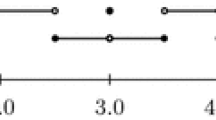Abstract
This paper presents an estimation approach for Time Event Graphs such as P-Time Event Graphs and Time Stream Event Graphs. It is assumed that the nominal behavior is known and that transitions are partitioned as observable and unobservable transitions. The technique is applied to the detection of changes which are (possibly small) finite variations of dynamic models compared to this nominal behavior. The detected changes provide indications that can be used in future maintenance operations. Using the algebra of dioids, the approach uses a receding-horizon estimation of the greatest state and analyzes the consistency of the data.


Similar content being viewed by others
References
Aramburo-Lizarraga J, Lopez-Mellado E, Ramirez-Trevino A, Ruiz-Beltran E (2007) Reliable distributed fault diagnosis using redundant diagnosers. In: DCDS’07, Cachan, France
Baccelli F, Cohen G, Olsder GJ, Quadrat JP (1992) Synchronization and linearity. An algebra for discrete event systems. Wiley, New York. Available from http://maxplus.org
Cochet-Terrasson J, Gaubert S, Gunawardena J (1999) A constructive fixed point theorem for min-max functions. Dyn Stab Syst 14:407–433
Courtiat J-P, Diaz M, De Oliviera RC, Sénac P (1996) Formal models for the description of timed behaviors of multimedia and hyper media distributed systems. Comput Commun 19:1134–1150
Declerck P (2007) Detection of changes by observer in Timed Event Graphs and Time Stream Event Graphs. In: DCDS’07. Cachan, France, pp 215–220. Available from http://www.istia.univ-angers.fr/~declerck/
Declerck P, Didi Alaoui K (2005) State estimation in time event graphs. Application to fault detection. In: 17th IMACS world congress, scientific computation, applied mathematics and simulation, Paris, France, 11–15 July. Available from http://www.istia.univ-angers.fr/~declerck/
Declerck P, Didi Alaoui MK (2010) Optimal control synthesis of timed event graphs with interval model specifications. IEEE Trans Automat Contr 55(2):518–523. Available from http://www.istia.univ-angers.fr/~declerck
Declerck P, Staroswiecki M (1991) Characterisation of the canonical components of a structural graph for fault detection in large scale industrial plants. In: First European control conference, ECC’91. Grenoble, France, vol 1, pp 298–303
Diaz M (2001) Les réseaux de Petri. Hermes
Didi Alaoui MK (2005) Etude et supervision des graphes d’événements temporisés et temporels : vivacité, estimation et commande. These de doctorat, ISTIA, University of Angers
Domlan EA, Ragot J, Maquin D (2007) Switching systems: active mode recognition, identification of the switching law. J Control Sci Eng 4:1–11
Giua A, Seatzu C (2005) Fault detection for discrete event systems using Petri nets with unobservable transitions. In: 44th IEEE conference on decision and control and European control conference, CDC-ECC’05. Seville, Spain, vol 135, pp 7–9, 12–15 December
Hashtrudi Zad S, Kwong RH, Wonham WM (2003) Fault diagnosis in discrete-event systems: framework and model reduction. IEEE Trans Automat Contr 48:1199–1212
Jard C, Chatain T, Bourhis P (2005) Diagnostic temporel dans les systèmes répartis à l’aide de dépliages de réseaux de Petri temporels. Journal européen des systèmes automatisés (JESA) 39(1):351–366
Jiang B, Staroswiecki M, Cocquempot V (2004) Fault estimation in nonlinear uncertain systems using robust/sliding mode observers. IEE Proc Contr Theor Ap (IEE-CTA) 151(1):29–37
Jiroveanu G, Boel RK, De Schutter B (2006) Fault diagnosis for Time Petri Nets. In: Wodes’06. Ann Arbor, Michigan, USA
Lefebvre D, Delherm C (2006) Diagnosis of DES with Petri Net models. IEEE Trans Autom Sci Eng 48:1199–1212
Di Loreto M, Gaubert S, Katz R, Loiseau J-J (2009) Duality between invariant spaces for max-plus linear discrete event systems. arXiv:0901.2915v1 [math.OC]. Available from http://amadeus.inria.fr/gaubert/papers.html
Luenberger DG (1964) Observing the state of a linear system. IEEE Trans Mil Electron MIL-8:74–80
Michalska H, Mayne DQ (1995) Moving horizon observers and observer-based control. IEEE Trans Automat Contr 40(6):995–1006
McMillan K, Dill D (1992) Algorithms for interface timing verification. In: Proceedings of the IEEE, international conference on computer design: VLSI in computers and processors
Pandalai DN, Holloway LE (2000) Template languages for fault monitoring of timed discrete event processes. IEEE Trans Automat Contr 45:868–882
Sampath M, Sengupta R, Lafortune S, Sinnamohideen K, Teneketzis DC (1996) Failure diagnosis using discrete-event models. IEEE Trans Control Syst Technol 4:105–124
Schullerus G, Krebs V, De Schutter B, van den Bom T (2006) Input signal design for identification of max-plus-linear systems, Automatica 42:937–943
Schullerus G, Krebs V (2001) Diagnosis of a class of discrete event systems based on parameter estimation of a modular algebraic model. In: Proceedings of the 12th international workshop on principles of diagnosis, pp 189–195
Simani S, Fantuzzi C, Patton RJ (2003) Model-based fault diagnosis in dynamic systems using identification techniques. Springer, Lavoisier
Walkup E (1995) Optimization of linear max-plus systems with application to timing analysis. PhD thesis, University of Washington
Author information
Authors and Affiliations
Corresponding author
Rights and permissions
About this article
Cite this article
Declerck, P., Guezzi, A. State estimation and detection of changes in time interval models. Discrete Event Dyn Syst 24, 53–68 (2014). https://doi.org/10.1007/s10626-012-0149-8
Received:
Accepted:
Published:
Issue Date:
DOI: https://doi.org/10.1007/s10626-012-0149-8




